Abstract
In the present work, the kinetics of the extraction process from female inflorescences of Canapa sativa subsp. sativa var. sativa were studied, on the basis of determination of the content of cannabinoids: cannabidiolic acid (CBDA), Δ9-tetrahydrocannabinolic acid (THCA), cannabidiol (CBD) and Δ9-tetrahydrocannabinol (THC), before and after decarboxylation in the oven, in order to evaluate the possible use of the hemp extract obtained in the food sector. Therefore, both conventional maceration (CM) and rapid solid-liquid dynamic extraction (RSLDE), also known as cyclically pressurized extraction (CPE), were carried out, using parts of the plant approximately of the same size. The alcoholic extracts thus obtained were analyzed by high-performance liquid chromatography (HPLC) in order to calculate the percentages of cannabinoids present in the inflorescences and thus be able to evaluate the degree of decarboxylation. Furthermore, the extracts were dried to calculate the percentage of solid material present in it, that was made mainly by cannabinoids. The amount of substance extracted from the inflorescences was about 10% (w/w), for both cases considered. Therefore, the extraction yield was the same in the two cases examined and the final qualities were almost identical. However, the extraction times were significantly different. In fact, the maceration of hemp inflorescences in ethyl alcohol was completed in no less than 24 h, while with the RSLDE the extraction was completed in only 4 h. Finally, for a better understanding of the extraction process with cyclically pressurized extraction, a numerical simulation was carried out which allowed to better evaluate the influence of extractive parameters.
1. Introduction
Cannabis (Linneus, 1753) or hemp is a genus of angiosperm plants of the Cannabaceae family [1,2]. There are different varieties of hemp, in turn divided into subspecies; the three best known and used species are: sativa, indica and ruderalis. Hemp has always been used in various sectors, such as textiles, nanomaterials, food and so on, as it is easy to grow, is resistant and needs little attention. In the food sector, for example, hemp flour can be produced for both sweet and savory baked goods. Furthermore, hemp seed is among the most nutritious, being made up of 25% (w/w) protein and containing all nine essential amino acids, as well as basic fatty acids such as omega 3 and omega 6, as well as a high amount of antioxidants such as vitamins and carotenes, combined with phytosterols and essential minerals, important for numerous human biological functions. In particular, a product of hemp is the oil obtained by squeezing the seeds. This oil, rich in omega-3 and omega-6, lowers cholesterol levels in the blood and, taken constantly, helps strengthen the immune system. Moreover, it can also be used in the cosmetic sector and even as a fuel [3]. Unfortunately, starting in the 1930s, strict legislation limited the use of hemp due to a psychotropic molecule present inside it, Δ9-tetrahydrocannabinol (THC). This limitation lasted until 2000, when an update of these laws made it possible to commercialize types of hemp with a THC content of less than 0.2% (w/w), allowing a renaissance of its cultivations, driven above all by the discovery of the therapeutic effects of two cannabinoid molecules present in hemp: the THC itself and the CBD, or cannabidiol [4]. These molecules act on receptors present in the human nervous system, regulating a series of human activities such as the sense of appetite, pain, memory, but also act as anxiolytics and allow to fight diseases of the nervous system such as epilepsy, schizophrenia, sclerosis and neurodegenerative damage in general [5,6]. Furthermore, receptors for cannabinoids have also been found in immune cells, in tissues of the gastrointestinal system, reproductive organs, heart and lungs, where the combined action of CBD and THC allows regulating fat metabolism, levels of insulin and the inflammatory state of tissues. Furthermore, some molecules such as lignans, present in the hemp plant, once ingested, are modified by the intestinal microbial flora, becoming hormone precursor molecules, able to counteract forms of hormone-dependent cancer [7].
Efficient extraction and analysis methods allow the accurate determination of the cannabinoid content and subsequent evaluation of the potential of the extracted material. Rapid solid-liquid dynamic extraction (RSLDE), based on the use of the Naviglio extractor, is an extraction technique that allows the optimization of diffusion and osmosis phenomena, increasing the yield of extraction and minor extraction times compared to traditional extraction methods [8]. Taking advantage of this principle, it is possible to conduct extraction at room temperature, making the diffusion effect due to temperature and, consequently, to convective motions negligible. The instantaneous liquid depression allows the active ingredients and other non-chemically bound substances to be forcibly extracted from the solid matrix, transforming a passive extraction process into one that is active and controllable by pressure, reducing matrix exhaustion times and ensuring reproducibility of the extraction date, giving the real possibility of standardizing extracts [9,10,11]. In this work, the extracts of female inflorescences of Cannabis sativa subsp. sativa var. sativa were characterized in order to assess the content of the cannabinoids CBDA, THCA, CBD and THC, before and after decarboxylation. Finally, a numerical method was used to describe the kinetics of extraction for conventional maceration and innovative solid-liquid extraction (RSLDE).
2. Material and Methods
2.1. Samples
The female inflorescences of Canapa sativa subps. sativa var. sativa used in this work were supplied by local producers and growers from the Campania region (Caserta, Italy). The inflorescences considered were cut into small particles that can be assimilated into an ellipsoidal shape with diameters ranging from half a centimeter to about one centimeter. The samples were kept in bags under vacuum and stored at −20 °C until use. Subsequently, the extracts obtained with the two solid–liquid extraction techniques (CME and CPE) were both analysed by high-performance liquid chromatography (HPLC) to compare the cannabinoids distributions.
2.2. Materials and Solvents
All reagents and solvents used in this study were of analytical reagent or HPLC grade and were purchased from Merck (Darmstadt, Germany). Standards used to identify cannabinoids were purchased from Sigma Aldrich (Milan, Italy), or, when not available, were purified using the same chromatographic conditions described in Section 2.8. (HPLC analysis) and identified by literature data. The quantification of the cannabinoids was obtained through the construction of calibration curves of CBDA, CBD, THCA and THC (Standards purchased from Sigma Aldrich, Milan, Italy). The female inflorescences of Canapa sativa subps. sativa var. sativa were identified by a local expert, selected visually in order to have a fairly homogeneous sample and then weighed on scales with 0.01 g accuracy (Gibertini Europe 1700, Novate Milanese, Milan, Italy), hermetically sealed to avoid variations in the moisture content and were stored at −20 °C in plastic containers under vacuum. Three determinations were carried out, all containing about 45 g of inflorescences, which, before the extraction process, were dried to obtain an average final degree of humidity of 10 ± 1% (w/w), by using oven method at 105 °C for 12 h [12].
The solid/liquid ratio used was 20 g of inflorescences in 550 mL of ethanol, whereas the average cannabinoid quantity was around 10% (w/w), thus the maximum calculated concentration was 4 g/L.
2.3. Extraction Process by Conventional Maceration (CME)
As it is known, maceration is an extractive technique that is conducted at room temperature. It consists of immersing some substances to extract certain components in a liquid (water, oil, alcohol, etc.) inside an airtight container, usually made of glass, for a variable time based on the matrix to extract and the liquid used. For industrial application, stainless steel (AISI 316L) containers are generally used for big volumes of liquid.
Extraction of essential oils from dry hemp inflorescences with ethyl alcohol by CME was performed by the following procedure: after drying, 40 g of solid matrix, accurately weighed, were placed in 1100 mL of ethanol 96% (v/v) in a glass container. The container was hermetically closed and kept at a constant temperature of 20 °C. The matrix was left to macerate for 24 h, stirring occasionally to facilitate the process. Subsequently, the extracted sample was filtered, labeled and stored at −20 °C before analysis.
Seven conventional maceration tests were performed. The ethanolic extract obtained was diluted in 96% ethanol (dilution factor 1:100) and analyzed by HPLC. The difference between the measured minimum and maximum dry residue of different batches was less than 5% (w/w), therefore the average values were considered for dry matter residue.
2.4. Cyclically Pressurized Extraction (CPE) Process (Rapid Solid-Liquid Dynamic Extraction (RSLDE)
Extraction of essential oils from dry hemp inflorescences with ethyl alcohol by CPE was performed by the following procedure: seven dynamic solid–liquid rapid extraction (RSLDE) tests were performed using 550 mL of 96% (v/v) ethanol as solvent and 20 g of dried hemp inflorescence. The total extraction time was 4 h. Specifically, the extraction was carried out using the Naviglio extractor Lab series mod. 500 (Atlas Filtri Engineering, Limena, Padua, Italy), with static phase 2 min and dynamic phase 2 min, pressure 8 bar, room temperature.
The ethanolic extract obtained was diluted in 96% ethanol (dilution factor 1:100) and analyzed by HPLC. During the tests considered, the difference between the minimum and maximum values for dry residue of different batches detected was lower than 5%, so the average values were considered for dry matter residue.
2.5. Determination of Solid Matrix Pieces Size
Before the determination of solid matrix piece size, the dried hemp inflorescences were shredded and compacted spheroidally, in very small 3D pieces, that formed the solid matrix. The sizes of solid matrix obtained by the hemp inflorescences, length, width and thickness, were measured using a digital calliper before and during the solid–liquid extraction process. From these values, the sphericity and geometric mean diameter (GMD) of the solid matrix pieces were determined [13] and then used in the numerical simulations to construct a mathematical model of the extraction process considered.
2.6. Determination of the Total Volume
To evaluate the volume without changes in the moisture content, the solid matrixes of pieces of hemp inflorescences were sealed with plastic material (food-grade polyethylene) that adhered perfectly to the shape of the solid matrix, and the volume was measured as the initial total (Vpt) by immersion for a few seconds in 500 mL of water in a graduated 1000 mL cylinder.
From this total initial volume (Vpt), the volume of the accessory masses (Va), which were previously determined, were subtracted and the result was the real volume (Vp) of the sample, which were determined as follows: Vp = (Vpt − Va).
2.7. Determination of the Initial Concentration of the Solid Matrix
The hemp inflorescence samples were stored at −20 °C in sealed plastic containers to avoid changes in moisture content and were mixed several times for 2 min before use. Before extraction, the concentration of the solid matrix (Mi = Ci) was determined, evaluating that the solid/liquid ratio used was 20 g of inflorescences in 550 mL of ethanol. Considering that the average cannabinoid quantity was about 10% (w/w), then the maximum concentration was 4 g/L. Therefore, the initial concentration was 0.4% (w/v).
After the determination of the initial weight and volume, the samples of the solid matrix components were subjected to the conventional maceration (CME) and the cyclically pressurized extraction process (CPE). The determination of the weight and volume parameters, performed as described above, was repeated at certain time intervals shown in the relative tables.
2.8. HPLC Analysis
HPLC analyzes were conducted with an Agilent Technologies chromatograph, with a high-performance liquid chromatography (HPLC, Agilent Technologies Inc., Waldbronn, Germany) equipped with a diode-array detector (HPLC/DAD). Chromatographic conditions were: Solvent A was 0.1% trifluoroacetic acid (TFA) in H2O and solvent B 0.1% TFA in acetonitrile (ACN). The gradient was: 20% A for 3 min.; 100% B at 20 min; hold for 5 min. The run had a total duration of 20 min and the flow rate was set at 1mL/min. Cannabinoids were detected at a wavelength of 215 nm. The trueness and precision of the HPLC method used were assessed by analyzing a standard sample of hemp inflorescences (Dietalinea, Società Agricola Eatruscan srl, Cesena (FC), Emilia-Romagna, Italy) for which all cannabinoids (CBDA, CBD, THCA and THC) were quantified and certified. Standard inflorescences were undergone to CME and CPE extraction procedures and alcoholic extracts of cannabinoids obtained were analyzed by HPLC under the same chromatographic conditions. These two procedures were repeated three times and the standard deviations for the cannabinoids analyzed were less than 3% for THC and CBD, while they were less than 2% for THCA and CBDA in both cases. Moreover, the results of analyses of alcoholic extracts obtained with CME and CPE procedures of extraction give good results for trueness; deviations for all cannabinoids (CBDA, CBD, THCA and THC) in respect of certified values analysed were less than 3% for both procedures of extraction.
2.9. Dry Residue
The dry residue of a liquid sample is that part which remains after the solvent is removed. The percentage of dry matter is very variable and depends on various factors, such as the quality of the sample, the method of extraction and drying. The previously weighed sample was dried at 80 °C for 24 h. In addition, temperatures of 110 and 120 °C for 15, 16, 20 and 22 min were also tested. At the end of drying, the sample was weighed again and the rate of dry substance was obtained with the formula:
Dry residue (%) = P’/P × 100, where P’ = weight in grams of the sample after dehydration; P = weight in grams of the sample before dehydration. The humidity of the sample is the percentage of water contained in it. It was calculated by difference, subtracting the dry residue, determined with the methodology indicated above, from 100.
2.10. Analytical Approach
To better understand the extraction phenomenon under investigation, analytical and numerical approaches available in the current literature were considered [14,15,16,17,18,19].
During a constant temperature diffusion process, it was assumed that the process follows the 3D Fick diffusion law
where M is the instantaneous concentration of the solute extract in the solid matrix at a specified time t and D is the diffusion coefficient.
If the diffusion process is performed in axial-symmetric conditions, we can consider Fick’s second law in 1D, in spherical coordinates. In this case, a suitable solution for a matrix with a spherical geometry with radius r, was shown by Crank (1975) [20], as follows:
M is the instantaneous concentration content at a specified time t
where MR is the concentration ratio and Mi and Me are the initial and equilibrium concentration contents of the sample during the extraction process, respectively. In most cases, only a finite number of Equation (2) is used to estimate MR values. In fact, most researchers used only the first two terms of this equation.
In this research, the experimental MR values at specific time intervals were calculated and used as input to the curve fitting toolbox of MATLAB (R2016) software and the diffusion coefficient of the solid matrix, D, was estimated at the time t. Since the general shape of an element of the considered solid matrix is closer to an ellipsoid than to a sphere, the diffusion coefficient should be adjusted in Equation (1). Gaston et al. (2004) presented a procedure to estimate the coefficient of diffusion for an ellipsoid (De) using the following equation [21]:
where fe is the sphericity factor of ellipsoid [22]. Then, the coefficient of diffusion D in Equation (2) should be replaced by the calculated value De.
De = fe2 × D
It should be kept in mind that Equations (1)–(4) were used to calculate a diffusion coefficient D (in approximate way) to be used in the finite element calculation code (which solves more general and more complicated equations), by which the simulation of the real phenomenon under consideration has been performed. That is, we calculate coefficients D (at different time), with a simplification, to be introduced in the finite element simulation model. While the final values are calculated by the program code, that performs the calculation correctly.
2.11. Finite Element Method Approach for CPE Process
To obtain the best understanding of the cyclically pressurized extraction (CPE) process, a numerical simulation was carried using the Comsol 5.1 software program, which enabled evaluation of the exchange between the solid matrix and the liquid solvent used, as well as the pressure distributions during the extraction process.
Using the finite element model, the time-dependent concentration distribution was numerically determined at given time intervals.
The solid matrix shape was considered as an ellipsoid. Due the symmetry of the problem, a two-dimensional domain considering only a quarter of the projected area by a spheroid with the same volume of the solid matrix piece was assumed.
A complete mesh consisted of 23,500 3D tetrahedral domain elements with 3000 internal nodes.
Moreover, the chemical physical behaviour was defined through the specification of the following parameters:
-effective diffusion coefficient for spheroidal geometry;
-initial essential oil content of solid matrix;
-equilibrium essential oil content of solid matrix;
-total experimental time of oils extraction.
The domain was discretized using 23,500 diffusion elements, with axial symmetry and one degree of freedom—concentration—at each node.
For a certain value of the initial concentration content, and for the proper diffusion coefficient of the material, the analysis evaluated the time-dependent concentration distribution at the nodes.
A similar approach has previously been used to determine the moisture and temperature fields during the cooling process in the cryomaceration of grapes [23,24].
In a finite element approach, an estimated value for D is supplied in Equation (1), and the MR values are numerically determined for specified locations at given time intervals. In applying this approach, the following assumptions were made for the individual solid matrix:
1. The diffusion coefficient is independent of the concentration.
2. The solid matrixes are isothermal and heat transfer during extraction process is neglected.
3. The solid matrixes are homogeneous and isotropic.
4. Throughout the extraction process, the surface of a solid matrix maintains saturation concentration (the boundary condition).
5. The solute initial content of the solid matrix is constant, and it is uniformly distributed within solid matrixes, (initial condition).
Mathematical modelling used by COMSOL 5.1 program code has been performed by mean:
(a) Concentration continuity Equation (General Convective-Diffusive)
where
ci = concentration of the solute -i-
Di = diffusion of the solute -i- in the solvent
u = velocity of the solute (in the considered case = 0)
When the velocity u = 0, the equation becomes only for purely diffusive phenomena. The transitory diffusion values are non-constant over time.
(b) Diffusive flux equation
where N is solute flux.
The simulation was performed for ¼ only of the total geometry, for symmetry. Symmetry walls have the normal component of the concentration gradient equal to 0, as follows:
Boundary Condition 1: normal component of the flux equal to 0 on the external edges (Neumann condition)
where n is the versor normal to the surface.
Boundary condition 2: described by Dirichlet Boundary condition from the data of extraction, as follows:
Ci = C (data from experiments) on the other boundary
On the walls, the normal component of the concentration gradient is equal to 0.
The coefficient of diffusion calculated by fitting Equation (2) to the experimental data was inputted into the software, and the equations were solved by a finite element approach to evaluate the Nodal Flux-time diagram for the component, as shown in the report by Naviglio et al. (2016) [16], where the distribution of the concentrations of each node, at one-second time steps, was evaluated.
The overall concentration for a solid matrix was also calculated at the time range considered by averaging the solute contents of the nodes.
All of these procedures were performed for the cyclically pressurized extraction (CPE) process, and precisely, the input parameters for the COMSOL program were:
(1) Diffusivity coefficient m2/s for the solute extracted, S.
(2) Uniform initial value mol/m3 (The relative activities of each fraction were determined on the basis of molar concentration (mol/L) or mass concentration (g/L).
(3) Mass flow that is withdrawn by mean kinetics curve.
(4) The mass flow, obtained from the diagrams of the kinetic curves (the derivative of the concentration in time is the mass flow, i.e., the slope of the curve in the kinetic diagram).
Figure 1 shows the geometric model of a hemp inflorescence and X, Y, Z are the axes with respect to which the geometry of the model was referred (mm) (Figure 1).
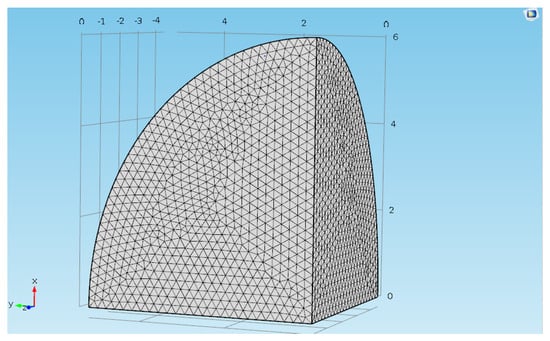
Figure 1.
Finite element grid for a single hemp inflorescence particle.
2.12. Statistical Analysis
The experimental data were expressed as mean ± standard deviation (SD) in triplicate and the p-values < 0.05 were considered as significant.
3. Results and Discussion
3.1. Drying
This is a very important parameter for the qualitative evaluation of products, as it determines the actual content in primary substances and nutritional elements. In practice, it is what remains in terms of the constituent elements of the matter following the elimination of the water contained in it. The percentage of dry matter is very variable; in the case of fresh vegetables, it is between 5% and 10%. The dry residue is expressed as a percentage of the weight of the examined sample.
Experimental tests have shown that hemp lost 11%–12% in weight after drying; furthermore, as already described above, acid cannabinoids (CBDA and THCA) undergo heat through non-enzymatic decarboxylation, i.e., the loss of CO2, leading to the formation of active cannabinoids (CBD and THC). Table 1 shows the data of the various drying tests, with variable time and temperature.

Table 1.
Hemp samples subjected to drying at different times and temperatures.
Therefore, drying allowed to us obtain a product of smaller size, but containing a phytocomplex rich in active substances. From the data of the different drying tests (Table 1), with variable time and temperature, it is possible to highlight that the percentage loss is always a value that fluctuates between 11% and 12%.
3.2. Kinetics Diagrams of CME and CPE Processes
Figure 2 shows the kinetics of the extraction process considered, during the conventional maceration extraction process (CME) and during cyclically pressurized extraction process (CPE).
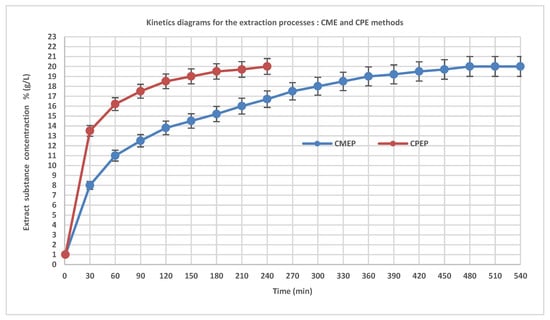
Figure 2.
Kinetics diagrams for the extraction processes: conventional maceration extraction process (CME) and cyclically pressurized extraction process (CPE), with error bars.
Each test was repeated seven times. The difference between the minimum and maximum value detected was lower than 5%, for that the mean values were considered. After 240 min, the two curves are detached by about 18% and reach the same saturation value at different times: 240 and 480 min. As it is possible to see from the diagram shown in Figure 2, using the CME process, the extraction time was about 8 h, while for the CPE process the extraction time was 4 h. The value of the extraction time was confirmed by various tests carried out: at a shorter time, the extractable material is still present in the matrix, and over 4 h the matrix is completely exhausted (after 4 h, the curve reaches a plateau). The quantity of substance extracted is about 10% (w/w) of the extracted inflorescence, for both cases considered.
In the literature, several applications of CPE process have been reported in which it is possible to find that the CPE process was much more efficient, as it allowed to drastically reduce the extraction times. The saturation value and time were also confirmed by the experimental data: in a shorter time, the extractable material was still present in the matrix, while after 4 h the matrix was completely exhausted [14,15,16,17,18,19].
From the seven starting samples, seven extracts were obtained; from these, 10 mL were taken, placed in an oven at 80 °C, and brought to dryness so as to allow the calculation of the dry residue, then another 10 mL were taken and diluted 1:100 with ethyl alcohol before HPLC analysis.
3.3. Dry Residue
Ten milliliters are taken from each extract sample and weighed. The samples are then placed in an oven at 80 °C, so that the ethanol content evaporates leaving only the dry substance, consisting of the phyto-complex. After 24 h, the samples are taken from the stove. The content is expected to reach room temperature and the different samples are weighed. Finally, the percentage of dry residue is calculated (Table 2) using the formula described above (see Section 2.9). The dry residue was determined in 14 samples; however, since the percentages of dry residue were comparable in the two processes, Table 2 shows only those obtained from the CPE process, because it concerned the most efficient process, especially in terms of extraction speed.

Table 2.
Dry residue of the different samples and calculation of dry residue percentage.
In addition to the decarboxylation carried out at 80 °C, two other decarboxylations, programmed at 110 and 120 °C, were also carried out to evaluate the weight variations according to the time/temperature parameters, as shown in Figure 3. The data were inserted in a graph that shows the percentage trend of the dry residue of the different samples at different times (15, 16, 20 and 22 min) (Figure 3).
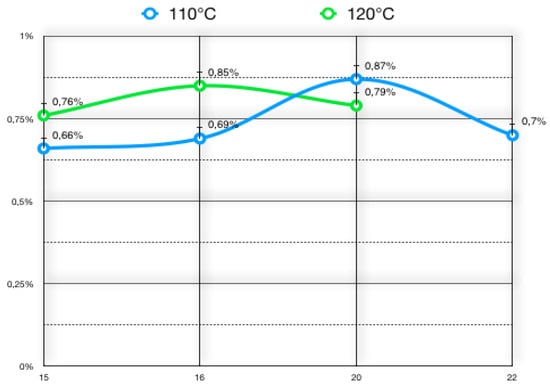
Figure 3.
Sample dry residual graph at different times (15, 16, 20 and 22 min).
For both decarboxylated samples at 110 and 120 °C, the graph shows a peak at values around 0.85%: this value indicates the maximum amount of phyto-compound present and removable from the sample.
3.4. HPLC Analysis
The HPLC analyses showed that, as the duration and temperature of drying in the stove changed, the percentage of decarboxylation of the acid cannabinoids also changed; there was the total conversion of THCA into THC, whose level is always less than 0.6% (maximum limit imposed by Italian law), while the CBDA has been partially converted.
The chromatograms of Figure 4 and Figure 5 show how the content of acidic and active cannabinoids changed after the hemp sample was subjected to decarboxylation.
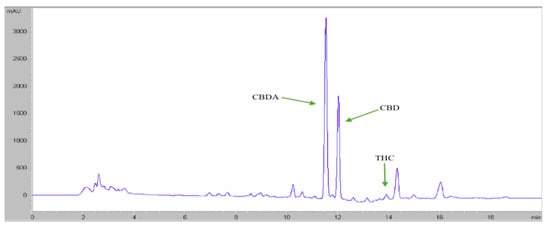
Figure 4.
High-performance liquid chromatography (HPLC) analysis of a pre decarboxylation hemp extract. (x-axis: time in minutes; y-axis: mAU).
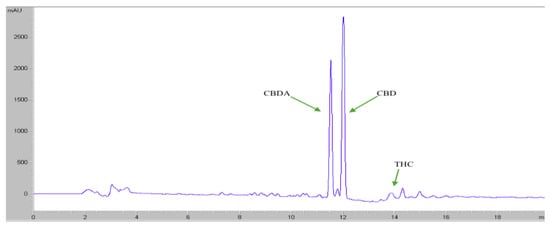
Figure 5.
HPLC analysis of a post decarboxylation hemp extract (x-axis: time in minutes; y-axis: mAU).
The data extrapolated from the chromatograms made it possible to calculate the percentages of cannabinoids present in the extracts (Figure 4 and Figure 5).
The samples analyzed had high levels of acid cannabinoids; active cannabinoids were present at low concentrations, in the order of 0.125% (CBD) and 0.021% (THC), values confirmed by preliminary analyzes.
From the data obtained, it is possible to note that in the samples subjected to 110 °C decarboxylation, there was a low CBDA conversion, while in the samples subjected to 120 °C decarboxylation, the CBDA content converted to CBD is doubled. Specifically, sample n.6 and n.7 have a higher CBD decarboxylation level than the remaining samples (Table 3).

Table 3.
Percentage of cannabinoids contained in the various hemp extracts.
3.5. Cyclically Pressurized Extraction (CPE) Process
For the CPE process, a range of extraction times, t = 0, 30, 60, 90, 120, 150, 180, 210, 240, min were considered until the saturation time, and after every time point considered, the dimensions of the solid matrix pieces were evaluated, precisely determining the following geometric characteristics:
L1 length along the x-axis of the considered particle (largest principal dimension, mm);
L2 length along the y-axis of the considered particle (second largest principal dimension, mm);
L3 length along the z-axis of the considered particle (smallest principal dimension, mm).
The physical characteristics of the solid matrix particles measured during CPE process are presented in Table 4.

Table 4.
The physical characteristics of the solid matrix particles measured during the CPE process.
Sphericity was assessed using the method reported in Jain and Bal (1997) [13]. The sphericity, Φ, of hemp is an index of the roundness of hemp. For non-spherical particles, sphericity is calculated as the ratio between the surface of the equivalent sphere and the surface of the hemp [25].
Based on the dimensions reported in Table 4, the solid matrix has a nearly ellipsoid geometry and retained its general shape after the extraction process. However, due to the relative decrease in the thickness and width of the solid matrix, the sphericity of hemp pieces changed from 0.9867 to 0.9847. The sphericity factor (fe) for a solid matrix mean particle ranged from 1.003 to 1.011. The decrease in dimensions was due to the migration of the solute content in the solid matrix particle cells, which caused an overall deflation of the solid matrix provides a detailed discussion of the changes in dimensions during the extraction process [26].
Using Equations (2) and (3), the coefficient of diffusion De has been calculated, and it has been ranged from 1.75 × 10−10 to 2.376 × 10−10 m2/s.
The values of De obtained in this case have been compared with those obtained with other types of extracts for traditional maceration, e.g., Cissè et al. (2012) calculated the coefficient of diffusion for the extraction of anthocyanins from Hibiscus sabdariffa within a range of 3.9 × 10−11 to 1.35 × 10−10 m2 s−1 between 25 and 90 °C [27], and Linares et al. (2010) estimated this coefficient for yerba mate aqueous extraction kinetics, ranging between 6.092 × 10−11 and 9.469 × 10−11 [28].
The higher De calculated for the considered extraction process indicates that the solute diffuses in the solid matrix at a higher rate than the considered cases.
3.6. Numerical Analysis
The obtained coefficient of diffusion was inserted into Equation (1), which was then solved using the finite element method, to estimate the concentration distribution within the solid matrix at various time intervals. The MR values were calculated for the time range considered. A visualization of the finite element method predictions of the concentrations is presented in Figure 6a–h at time t = 30, 60, 90, 120, 150, 180, 210, and 240 min after the start of the extraction process.
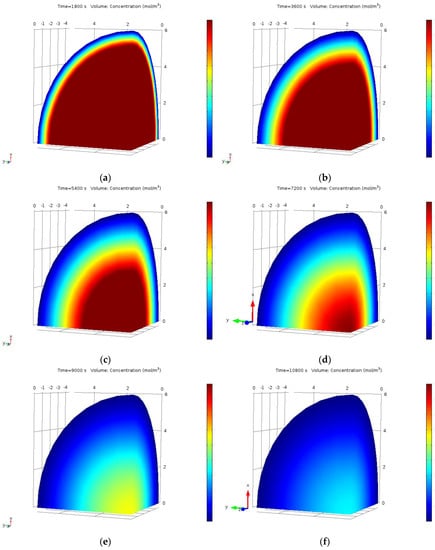
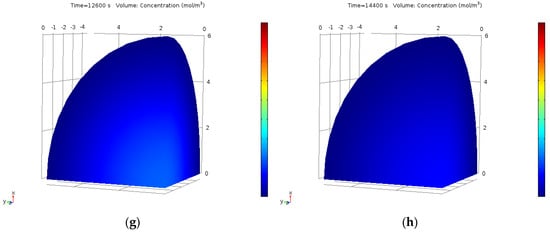
Figure 6.
(a–h) show a gradual migration of the extracted solute from the centre of the solid matrix to the surface. (a) Concentration values at time t = 30 min. (b) Concentration values at time t = 60 min. (c) Concentration values at time t = 90 min. (d) Concentration values at time t = 120 min. (e) Concentration values at time t = 150 min. (f) Concentration values at time t = 180 min. (g) Concentration values at time t = 210 min. (h) Concentration values at time t = 240 min. Theoretically, the finite element model, as shown in Figure 6a–h, indicates that even at the end of the extraction process, the concentration throughout the solid matrix is not uniform.
During the cyclically pressurized extraction of a solid matrix, there is a rapid initial water uptake that most likely occurs due to the filling of capillaries on the surface of the seed coats and hilum [29]. As water absorption proceeds, the rate begins to decrease due to the increased extraction of soluble material from the solid matrix and the filling of capillaries and intermicellar spaces with water [30].
In summary, to study the kinetics of the extraction process for the production of hemp inflorescences extracts by means of conventional maceration and rapid solid–liquid dynamic extraction (RSLDE), it has been necessary to characterize the samples considered, materials and solvent used, and to evaluate the extraction process by conventional maceration (CME) and the Cyclically pressurized extraction (CPE) process considered. Furthermore, to better understand the examined process, numerical simulation of the CPE process was performed; therefore, it was necessary to evaluate the solid matrix pieces size, the total volume of the considered samples, and the initial concentration of the solid matrix. Subsequently, HPLC analysis and evaluation of the dry residues of the material considered were performed. Finally, analytical and finite element method approach for the considered CPE process were examined, taking into account the data results of the kinetics of the considered processes.
4. Conclusions
The whole production process of the hemp extracts described in this work can be defined as ecological. In fact, the ethanol used was recovered for new extractions; the exhausted matrix can be used for the production of pellets to be used as fuel or as fertilizer. Analysis of the organic extract by HPLC confirmed the non-enzymatic decarboxylation of cannabinoid acids and the presence of active cannabinoids. THCA was decarboxylated into THC, a psychoactive substance, but its content remained below 0.6% (w/w). As is known, hemp is a plant that requires low management costs; on the other hand, it has numerous applications in various fields, from food, to ecological, to chemical and so on. However, the use of this plant still presents some doubts, both from a political and medical point of view. Therefore, it is important to encourage scientific studies of the substances it contains and the effects of cannabinoids. As for the addition of the extract containing the phytocomplex to food matrices, such as vegetable oils, the results obtained from this work are promising for the potential beneficial effects of the extract, but further investigations will have to be conducted to evaluate their real functionality.
Author Contributions
Conceptualization, M.G. and D.N.; methodology, M.C. and G.F.; software, A.F.; formal analysis, M.C. and G.F.; writing—original draft preparation, M.G., A.F. and D.N.; writing—review and editing, M.G., A.F. and D.N.; supervision, M.G. and D.N. All authors have read and agreed to the published version of the manuscript.
Funding
This research received no external funding.
Acknowledgments
The authors wish to acknowledge Dietalinea, Società Agricola Eatruscan srl, Cesena (FC), Emilia-Romagna, Italy for technical support. They would also like to acknowledge Dr. Antonio Polcaro (Polcaro Fitopreparazioni) for assistance during the experimental part.
Conflicts of Interest
The authors declare no conflict of interest.
References
- Bonini, S.A.; Premoli, M.; Tambaro, S.; Kumar, A.; Maccarinelli, G.; Memo, M.; Mastinu, A. Cannabis sativa: A comprehensive ethnopharmacological review of a medicinal plant with a long history. J. Ethnopharmacol. 2018, 227, 300–315. [Google Scholar] [CrossRef]
- Asadi, S.; Moghadam, H.; Naghdi Badi, H.; Naghavi, M.R.; Salami, S.A.R. A review on agronomic, phytochemical and pharmacological aspects of cannabis (Cannabis sativa L.). J. Med. Plant. 2019, 2, 1–20. [Google Scholar]
- Foti, V.T.; Scuderi, A.; Bellia, C. Actuality and future prospects of Cannabis sativa L. crops. features and problems. Quality-Access to Success 2019, 20, 255–262. [Google Scholar]
- Haney, M.; Hill, M.N. Cannabis and cannabinoids: From synapse to society. Neuropsychophamacology 2018, 43, 1–3. [Google Scholar] [CrossRef]
- Zou, S.; Kumar, U. Cannabinoid receptors and the endocannabinoid system: Signaling and function in the central nervous system. Int. J. Mol. Sci. 2018, 19, 833. [Google Scholar]
- Sarne, Y. Beneficial and deleterious effects of cannabinoids in the brain: The case of ultra-low dose THC. Am. J. Drug Alcohol Abuse 2019, 45, 551–562. [Google Scholar] [CrossRef]
- Andre, C.M.; Hausman, J.F.; Guerriero, G. Cannabis sativa: The plant of the thousand and one molecules. Front. Plant Sci. 2016, 7, 19. [Google Scholar] [CrossRef]
- Naviglio, D. Naviglio’s principle and presentation of an innovative solid–liquid extraction technology: Extractor Naviglio®. Anal. Lett. 2003, 36, 1647–1659. [Google Scholar] [CrossRef]
- Gigliarelli, G.; Pagiotti, R.; Persia, D.; Marcotullio, M.C. Optimisation of a Naviglio-assisted extraction followed by determination of piperine content in Piper longum extracts. Nat. Prod. Res. 2017, 31, 214–217. [Google Scholar] [CrossRef]
- Caprioli, G.; Iannarelli, R.; Sagratini, G.; Vittori, S.; Zorzetto, C.; Sánchez-Mateo, C.C.; Rabanl, R.M.; Quassinti, L.; Bramucci, M.; Vitali, L.A.; et al. Phenolic acids, antioxidant and antiproliferative activities of Naviglio® extracts from Schizogyne sericea (Asteraceae). Nat. Prod. Res. 2017, 31, 515–522. [Google Scholar] [CrossRef]
- De Marco, A.; Luongo, G.; Di Marino, C.; De Tommaso, G.; Di Fabio, G.; Zarrelli, A. Silymarin from Silybum marianum by Naviglio’s extractor: A new and very efficient approach. Nat. Prod. Res. 2019, 1–7. [Google Scholar] [CrossRef]
- Official Methods of Analysis of the Association of Official Analytical Chemists; Williams, S., Ed.; AOAC (Association of Official Analytical Chemists): Arlington, VA, USA, 2016. [Google Scholar]
- Jain, R.K.; Bal, S. Properties of pearl millet. J. Agric. Eng. Res. 1997, 66, 85–91. [Google Scholar] [CrossRef]
- Naviglio, D.; Formato, A.; Gallo, M. Comparison between 2 methods of solid-liquid extraction for the production of Cinchona calisaya elixir: An experimental kinetics and numerical modeling approach. J. Food Sci. 2014, 79, E1704–E1712. [Google Scholar] [CrossRef]
- Gallo, M.; Formato, A.; Ianniello, D.; Andolfi, A.; Conte, E.; Ciaravolo, M.; Varchetta, V.; Naviglio, D. Supercritical fluid extraction of pyrethrins from pyrethrum flowers (Chrysanthemum cinerariifolium) compared to traditional maceration and cyclic pressurization extraction. J. Supercrit. Fluids 2017, 119, 104–112. [Google Scholar] [CrossRef]
- Naviglio, D.; Formato, A.; Vitulano, M.; Cozzolino, I.; Ferrara, L.; Zanoelo, E.F.; Gallo, M. Comparison between the kinetics of conventional maceration and a cyclic pressurization extraction process for the production of lemon liqueur using a numerical model. J. Food Process Eng. 2017, 1–14. [Google Scholar] [CrossRef]
- Gallo, M.; Formato, A.; Formato, G.; Naviglio, D. Comparison between two solid-liquid extraction methods for the recovery of steviol glycosides from dried stevia leaves applying a numerical approach. Processes 2018, 6, 105. [Google Scholar] [CrossRef]
- Gallo, M.; Formato, A.; Ciaravolo, M.; Langella, C.; Cataldo, R.; Naviglio, D. A water extraction process for lycopene from tomato waste using a pressurized method: An application of a numerical simulation. Eur. Food Res. Technol. 2019, 245, 1767–1775. [Google Scholar] [CrossRef]
- Gallo, M.; Formato, A.; Giacco, R.; Riccardi, G.; Luongo, D.; Formato, G.; Amoresano, A.; Naviglio, D. Mathematical optimization of the green extraction of polyphenols from grape peels through a cyclic pressurization process. Heliyon 2019, e01526. [Google Scholar] [CrossRef]
- Crank, J. The Mathematics of Diffusion; Oxford University Press: New York, NY, USA, 1975. [Google Scholar]
- Gaston, A.L.; Abalone, R.M.; Giner, S.A.; Bruce, D.M. Effect of modelling assumptions on the effective water diffusivity in wheat. Biosyst. Eng. 2004, 88, 175–185. [Google Scholar] [CrossRef]
- Gaston, A.L.; Abalone, R.M.; Giner, S.A. Wheat drying kinetics. Diffusivities for sphere and ellipsoid by finite elements. J. Food Eng. 2002, 52, 313–322. [Google Scholar] [CrossRef]
- Carillo, M.; Formato, A.; Fabiani, A.; Scaglione, G.; Pucillo, G.P. An inertizing and cooling process for grapes cryomaceration. Elect. J. Biotechnol. 2011, 14, 6. [Google Scholar] [CrossRef]
- Naviglio, D.; Formato, A.; Scaglione, G.; Montesano, D.; Pellegrino, A.; Villecco, F.; Gallo, M. Study of the grape cryo-maceration process at different temperatures. Foods 2018, 7, 107. [Google Scholar] [CrossRef]
- McCabe, W.L.; Smith, J.C.; Harriott, P. Unit Operation of Chemical Engineering, 7th ed.; McGraw Hill, Inc: New York, NY, USA, 1997. [Google Scholar]
- Ahromrit, A.; Ledward, D.A.; Niranjan, K. High pressure induced water uptake characteristics of Thai glutinous rice. J. Food Eng. 2006, 72, 225–233. [Google Scholar] [CrossRef]
- Cissé, M.; Bohuon, P.; Sambe, F.; Kane, C.; Sakho, M.; Dornier, M. Aqueous extraction of anthocyanins from Hibiscus sabdariffa: Experimental kinetics and modeling. J. Food Eng. 2012, 109, 16–21. [Google Scholar] [CrossRef]
- Linares, A.R.; Hase, S.L.; Vergara, M.L.; Resnik, S.L. Modeling yerba mate aqueous extraction kinetics: Influence of temperature. J. Food Eng. 2010, 97, 471–477. [Google Scholar] [CrossRef]
- Hsu, K.H.; Kim, C.J.; Wilson, L.A. Factors affecting water uptake of soybeans during soaking. Cereal Chem. 1983, 60, 208–211. [Google Scholar]
- Plhak, L.C.; Caldwell, K.B.; Stanley, D.W. Comparison of methods used to characterize water imbibition in hard-to-cook beans. J. Food Sci. 1989, 54, 326–336. [Google Scholar] [CrossRef]
© 2020 by the authors. Licensee MDPI, Basel, Switzerland. This article is an open access article distributed under the terms and conditions of the Creative Commons Attribution (CC BY) license (http://creativecommons.org/licenses/by/4.0/).